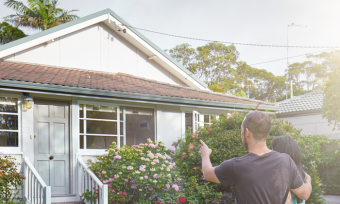Co-author: Olivia Fairhurst
As at April 2019, a total of $964 million in lending was loaned to first home buyers in New Zealand in the previous year. And, of this, $387 million was at a Loan to Value (LVR) ratio of more than 80% – meaning the first home buyer had a deposit of less than 20%. This works out to be more than 40% of the lending to first home buyers going to borrowers who had a deposit of less than 20%.
This is a significant increase from the $868 million of lending to first home buyers – $275 million at an LVR of more than 80% – in April 2018.
Compare first home buyer loans
But buyer beware. Latest research from Canstar shows a smaller deposit home loan can come with some expensive strings attached. You don’t have to rule out this option altogether, just make sure you weigh up any potential extra fees.
What is a low equity fee and how does it work?
Lenders who issue home loans with a deposit of less than 20% will typically charge either a low equity margin, or a low equity fee. Both are additional charges, but they have different impacts.
Lenders add these additional costs to high LVR loans because they are taking on a greater risk.
A low equity fee is when lenders charge an upfront amount to borrowers who have a deposit of less than 20%. The fee is based on a percentage dollar amount of the loan amount; the higher the LVR, the higher the upfront fee. The fee may be included in the loan.
For example, let’s say a borrower from Auckland takes out a one-year fixed home loan on a property at the median house price, as at June 2019, of $850,000. In this scenario, they have saved up a 10% deposit (so, an LVR of 90%). This means they will borrow $765,000 from the bank. They have locked in a one-year-fixed rate of 4.57%, with a loan term of 25 years.
If this borrower goes to a bank that charges an upfront low equity fee of 0.75% of the total loan; in this case, $5737.50 would be added to the loan amount. This brings the total loan to $770,737.50. The Auckland house buyer would pay $4314.69 per month. This works out to $258,881.40 in repayments over five years and a total cost of $166,091.46 over five years.
Any extra charge slapped onto the loan sounds pretty unappealing, right? Especially after working so hard to save for a deposit in the first place. But watch what happens to the loan if the bank applies a low equity margin, instead.
What is a low equity margin and how does it work?
A Low Equity Margin (LEM) is added to the home loan interest rate for borrowers with an LVR of more than 80% – meaning they have a deposit of less than 20%. The higher the LVR (the lower the deposit) the greater the margin the lender will apply.
According to Canstar’s research, lenders will generally apply margins, based on the following LVR bands for loans:
- 80.01% to 85%
- 85.01% to 90%
- 90.01% to 95%
- Greater than 95.01%
If the same borrower, with the same 10% deposit of $85,000, goes to a bank that charges a low equity margin, the house buyer won’t have to pay an upfront fee. However, they will pay much more in the long run. That’s because the interest rate of 4.57% on the one-year-fixed rate loan is increased – in this case by 0.75% – increasing the home loan rate to 5.32%.
Looking at repayments over a five-year period, what that means in real terms is that the first home buyer would end up paying $4615.89 per month in repayments (for the first 33 months) and then $4431.20 for the remainder of the five-year term. The reason this payment decreases after three years is because the LVR has reduced due to loan repayments, meaning the lender has reduced the low equity margin applied after the first 33 months. In this scenario, the house buyer would pay $271,966.97 in total repayments over five years and a total cost of $185,771.44.
The difference between the cost of a low equity margin scenario and a low equity fee situation is much, much more than pocket change:
Have a look at the different scenarios for our Auckland house buyer:
| Loan with the low equity fee applied upfront | Loan with the low equity margin applied | Difference | |
|---|---|---|---|
| Monthly repayments | $4314.69 per month | $4615.89 (for first 33 months)
$4431.20 (for the remainder of the five years) |
$301.20 (for first 33 months)
$116.51 (for remainder of the five years) |
| Repayments after five years | $258,881.40 | $271,966.67 | $13,085.27 |
| Total cost* after five years | $166,091.46 | $$185,771.44 | $19,679.98 |
| *Total cost= the total amount of interest charged on the loan | |||
What happens to the low equity margin when I start paying off my loan?
For the conscientious saver, it is possible to reverse your bad fortune down the track. As mentioned before, a first home buyer with a deposit of less than 20% will quite likely have to pay either a low equity fee, or a low equity margin. In the case of a low equity margin, you do have the chance to reduce the low equity margin, ultimately reducing your monthly repayments.
As the first home buyer starts making repayments on their home loan, the LVR on the first home buyer loan will gradually reduce. This means, down the track, the borrower can apply to their lender to have the margin reviewed.
Low equity margin review: A case study
Say a borrower has a 95% LVR loan (so a 5% deposit) for a house valued at $585,000. In this case, the bank offers an interest rate of 4.57%. But, because the loan is 95% LVR, the bank applies a low equity margin of 1.3%, on top of the interest rate; this brings the total interest rate to 5.87%. The borrower will have to make repayments of $3536.67 per month.
However, in a year’s time, the first home buyer has the potential to be in a much better financial position – which can mean good news for their back pocket.
After 12 months, the borrower’s home value has increased to $606,000 – $21,000 more than at the outset of the loan term. This example assumes the house has increased in value by 3.6% over a 12-month period.
Over this 12-month period, the borrower has made just over $42,000 in repayments, which has reduced the principal (the amount borrowed) by $9222.
The borrower then applies to the lender to reduce the 1.3% low equity margin – because the LVR is now sitting at just under 90%.
In this example, the bank reduces the margin to 0.75%, so the total interest rate is 5.32%. The borrower will now pay $3353.21 per month in repayments ($181.46 less a month than the initial repayments).
Pros and cons of low deposit home loans
| Pros | Cons |
|---|---|
| For some first home buyers, saving up the 20% deposit could be more of the battle than ensuring you can make future mortgage repayments. | A deposit of less than 20% will likely come with additional charges, either upfront or down the track, because the lender is taking on a greater risk. |
| A smaller deposit could mean you can get on the property ladder faster, to start paying off your own asset – rather than someone else’s. | A smaller deposit puts you in a weaker position when it comes to negotiating rates. |
| The disadvantages of having a low-equity deposit don’t have to last forever. For example, you can reduce a low equity margin as you start making repayments. | The less you pay towards the house now, the more you’ll have left to pay to the lender– and the more debt there is left to incur interest. |




Share this article